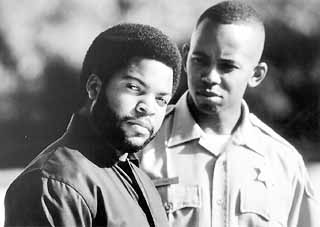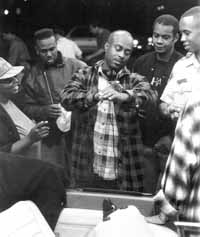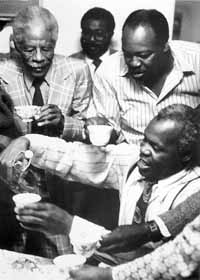https://www.austinchronicle.com/screens/1999-01-15/521004/
Far from Hollywood
By Charles Nafus, January 15, 1999, Screens
|
|
In the late 1960s, Burnett realized that he wanted to write and direct films about people he knew, about real life, about the dignity of the daily struggle just to make an honest dollar and hold the family together. A proponent of realism, he has become the Gustav Flaubert and Henry James of his South-Central Los Angeles community by creating minutely detailed stories depicting the simple but often heroic acts of people trying to follow a strong moral code, no matter the cost. His characters know right from wrong, not simply because a preacher told them or because they fear the fires of Hell, but because they have lived, observed, thought, and decided that treating others decently is the simplest and best rule for humanity. By closely looking at the specific and the ordinary in his characters, Charles Burnett has borne witness to the universal and the extraordinary inherent in all people's lives.
Born in Vicksburg, Mississippi in 1944, Charles Burnett moved to Los Angeles with his family at the same time he was learning to walk. This future recipient of the MacArthur Award (commonly known as the genius grant) began his study of cinematography and creative writing when he entered UCLA in 1967. Burnett recalls that "it was so cheap and much better in a certain sense [than USC, which was closer to home] because you were told to take the cameras out and go make a film, and don't come back with anything we've seen before. It was anti-Hollywood whereas USC was so departmentalized."
One of the few persons of color enrolled in the UCLA film department at first, he was eventually joined by others who shared his desire to explore new stories and means of telling them through a camera. When Eliseo Taylor began teaching at the school and started the Ethno-Communications program, the creative atmosphere began to heat up. Serving as a student-teacher, Burnett fully participated in the creation and discussion of films. He had already made a short film in 1969, "Several Friends," about young people in a South-Central community.
|
|
Remarking on living in the film capital of the world, Burnett explains, "At that particular time, Hollywood was totally closed. For people of color there was no chance to get in there. You made independent films, you did the work and got the money yourself, you put the project together and hopefully maybe a company like Churchill might pick it up. You couldn't get a position [in the studios] until that whole thing with the unions broke down. So, there was never any concern or a desire or dream of working in a studio. You made films because you were crazy enough to get involved and had the dream of thinking you could do something. I think we were our principal audience and so we sort of fed off each other."
With this amazing foundation in filmmaking technique, theory, and analysis, Burnett and his fellow students went forth to make their own cultural statement. Elsewhere, Burnett has stated: "I began making films wanting to tell a story about all the people I knew and worked with, the problems that they're facing, and how they were getting on. ... It's not that I set out purposely to create an alternative cinema. I was just trying to tell a decent story with real people. I think that if people are intelligent characters, that just makes the story more interesting."
After working on Haile Gerima's Bush Mama in 1976, Burnett wrote and shot "The Horse," a metaphorical short meditation on the South and its need for change. In 1977, Charles Burnett was finally able to make his first feature, Killer of Sheep. This provocative 16mm film, which served as his UCLA thesis, ponders the life of an African-American man who works in a slaughterhouse and dreams futilely of a better life. Declared a "national treasure" and added to the National Film Registry, Killer of Sheep draws devastatingly sharp parallels between the character's psychological and economic struggles. The film was shot on weekends for over a year and "it was done as a social documentary, like it was just captured. The lighting was unglamourous because we were trying to create a documentary look, doing everything in the camera." The Sundance jury also responded to this bracing thesis film by awarding it its grand jury prize.
In 1984, Burnett's screenplay, Bless Their Little Hearts, about a man trying to keep his family together and make a living the best way he can was directed by Billy Woodberry with Burnett behind the camera. That same year started Burnett's travails with My Brother's Wedding, an insightful story about a young man torn between his family and his friends. England's Channel 4 and German television conglomerate ZDF financed the film. Trouble started soon after Everett Silas, the lead actor, refused to act in any more scenes until he was paid a larger salary. Once that was settled and a few more scenes were in the can, Silas went off to become a preacher. Somehow after a year of start-stop filming, the principal photography was finished. When ZDF began demanding a version of the film, Burnett shipped off a rush-assembly first cut, and that became the only version of the film to exist. He still hopes to get enough money someday to go back and edit the film the way he really envisioned it. The best thing about the experience was meeting Gaye Shannon, who acted in the film, and became Burnett's wife.
|
|
Burnett comments, "The whole issue I wanted to ask in the film was: Is there evil in the world and in what form and shape does it come? When I was a kid, this sort of thing of people believing in magic and voodoo was so much a part of the environment I came from. When you're a kid you don't necessarily believe in it but everybody else does, so it was always a big question. As years go by, somehow or another it comes back on you and you kind of begin to respect it if nothing else. Harry is based on this folkloric trickster called 'Harry Man' so he's this character that will come and steal your soul. You have to argue or trick him to get it back. Folklore was such a big part of my growing up. At least it was there, people talked about it and told stories." Burnett wanted To Sleep With Anger to serve as a cautionary tale for younger viewers who might follow callow young men in an attempt to leave everything behind, including the family and heritage. "When I was growing up there was a sense of family, community, and structure. Without that everything is open for chaos. You don't have something that kind of glues people together."
Making a foray into a more critical analysis of entrenched racism, Burnett next took on The Glass Shield in 1994. The movie, which stars Michael Boatman, Ice Cube, and Lori Petty, tells the story of a man who becomes the first black officer appointed to the L.A. sheriff's department and becomes caught in the cross-hairs of the police fraternity's cold-blooded and racist corruption. Burnett says of the main character in The Glass Shield, "I think with this character I was trying to show where a guy unwittingly becomes a part of this conspiracy, thinking he's doing the right thing, that we all can identify with a situation where if a little lie can save the day then I'll do it. You can't be too rigorous and principled ... that's the problem; where do you draw the line? ... Everything in the movie was based on fact. A couple of the events were pulled from the newspaper and put together to make one narrative. ... The question I had was, can you think you're doing something morally right and then end up doing something morally wrong?"
After making a short in 1995, "When It Rains," Burnett began working on Nightjohn, adapted for the Disney Channel from a young adult's novel by Gary Paulsen. It is a wondrous story of a young slave girl being taught to read by a runaway slave who endangers his life by returning to the South to teach anyone who will listen. Working on a former slave plantation was almost unnerving for Burnett: "You always feel weird, or at least I did. With the slave cabins you keep connecting with the past. You're out there at night shooting and when they cut the lights out, there's nothing you can see. ... You wonder how the Underground Railroad helped them escape with all the alligators and razor grass that will cut you to shreds. There are all sorts of things that would be prohibitive to escape: heat, mosquitoes. You can get a teeny, tiny inkling of what they went through."
In 1997 Burnett was hired by Harpo Films (Oprah Winfrey's company) to direct Dorothy West's novel, The Wedding, as a television miniseries. Even though he saw a lot of problems with the teleplay, he accepted the assignment provided he was allowed to make changes. He found the story to be actually anti-black and anti-male. He loved working with Halle Berry and for the third time with Carl Lumbly, but the promised changes were rescinded and he ended up having to shoot it pretty much as written. The best thing, he says, is that it proved not to be an embarrassment to him.
In 1998 Burnett made his tribute film to Dr. Endesha Ida Mae Holland, civil rights activist and author of a memoir, From the Mississippi Delta. He also directed an ABC-movie, Selma, Lord, Selma, which will be broadcast later this month. This project concerns two little girls who witnessed the civil rights movement in 1965 during preparations for Martin Luther King's march on Selma. Burnett was most interested in portraying "the uplifting spirit of these little girls who encourage their family and friends to get involved." He won't be showing "a major miracle" but is pleased to once more reveal that "things that are ordinary in a certain way have larger possibilities."
Starting on January 19 and running consecutive Tuesdays (except for February 2) Austin movie audiences will have a rare chance to see five feature films by Charles Burnett under the sponsorship of the Austin Film Society's Free Cinema Series. Showtime is 7pm at the Texas Union Theatre; admission is free.
Charles Nafus is a member of the board of the Austin Film Society.
Copyright © 2024 Austin Chronicle Corporation. All rights reserved.



